Hello there, and welcome back to yet another guitar review article. It’s been a while since I posted a guitar review article here! Although it’s a lot more costly to purchase guitars and feature them here in a blog post rather than a guitar pedal, I must say I enjoy writing real reviews of guitars I try than anything else! 🙂
Table of Contents
Last time, we had a look at one of the best vintage vibe Stratocasters, the Fender FSR MIJ Hybrid II Stratocaster!
This time, we are going to look at one of the most popular yet affordable electric guitars released in recent years, the PRS SE DGT!
As always, you may question why purchase another guitar when you already have multiple guitars? Well, it’s an addiction, and a love thing! 🙂 There’s nothing more exciting than trying a different guitar design by a different guitar manufacturer. Although I didn’t need another guitar, I was really interested in the original PRS guitar designs and wanted to give it a try without breaking the bank.
As you may know, PRS Guitars are typically considered high-end, boutique-level instruments (made in the USA, Core models), and not very affordable for many hobbyists. But thanks to the excellent product segmentation executed by the company, now we can get a glimpse of these uniquely designed instruments at a very competitive price tag.
As I always do, I will provide you with a highly detailed overview and a review of this lovely instrument, as well as a no-talking sound demo video and original photos of the guitar in this PRS SE DGT review.
First, let’s quickly have a look at the PRS Guitars company briefly here.
About PRS Guitars – Decades of Tone, Craft, and Innovation
The late ’70s were where it all began. In 1976, Paul Reed Smith built his very first guitar as a college project — and that simple assignment turned into a lifelong obsession. By the early ’80s, Paul was already making waves with clever innovations.
He tackled age-old guitar problems head-on, like inventing a compensated nut to fix intonation issues and designing a tremolo system that actually stayed in tune (thanks, Carlos Santana, for the push!).
By 1984, things started getting serious. Paul hit the road with two prototypes in the backseat of his truck, visiting guitar shops up and down the East Coast. His hard work paid off when Sam Ash placed the very first big order — 30 guitars. That moment helped launch PRS Guitars officially in 1985.
Within a year, PRS had built its 1000th guitar and was already catching the attention of major players. The company’s mix of modern precision and vintage soul resonated with musicians around the world.
The early ’90s brought big milestones — a new double-action truss rod design, the now-legendary Dragon I guitar (a dream Paul had since he was 16), and the introduction of the McCarty model, a tribute to Paul’s mentor and Gibson legend, Ted McCarty.
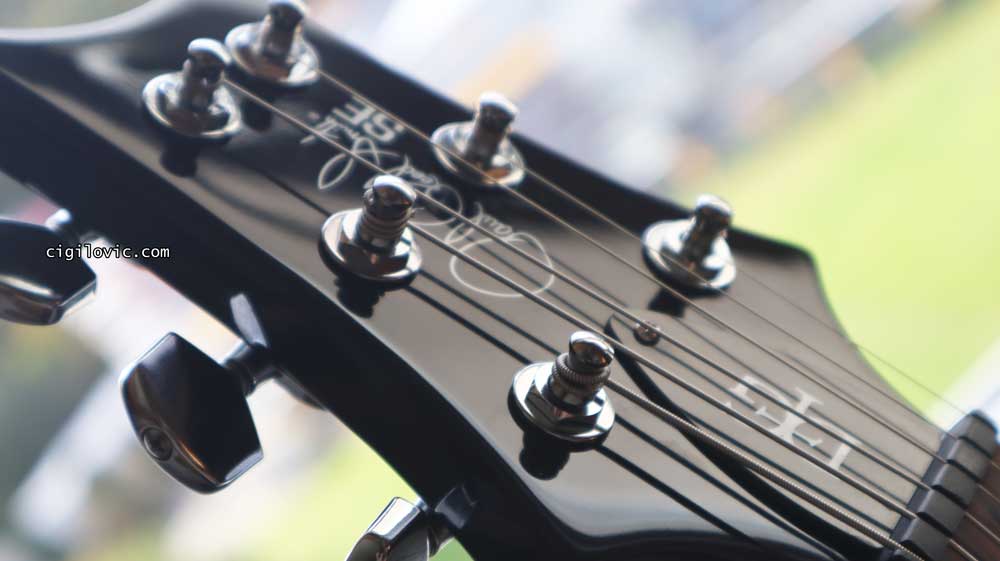
By the mid-’90s, PRS outgrew its Annapolis shop and moved to a new factory on Kent Island, Maryland. Around this time, the Private Stock program launched — where PRS’s most skilled luthiers built one-of-a-kind instruments that blurred the line between tool and art.
From there, PRS became part of guitar history — literally. A Dragon I model was added to the Smithsonian’s collection in Washington, D.C., and before long, PRS hit 100 employees and global recognition.
The 2000s marked another wave of innovation. PRS introduced piezo-equipped guitars, the affordable SE line (starting with the Santana SE), and later, their own amps and acoustics.
Despite a few legal battles and growing pains, PRS kept pushing forward — even winning back the right to build the Singlecut model after a lengthy court fight with Gibson.
By the 2010s, PRS was unstoppable. They launched the S2 Series, expanded the SE lineup, and teamed up with John Mayer to create the now-iconic Silver Sky — a guitar that made such a splash it temporarily crashed PRS’s website on launch day.
More recently, PRS has refined their pickup technology (TCI), opened new dedicated factories overseas, and even developed its own line of proprietary strings. All while keeping the same obsession with tone and detail that started it all.
Today, PRS employs more than 400 people and continues to craft some of the most respected guitars on the planet — from the Maryland-made Core and Private Stock models to the SE and S2 lines that bring PRS magic to every kind of player.
Nearly fifty years later, the mission is still the same: build guitars that inspire players to dream big, play better, and fall in love with the instrument all over again!
PRS SE DGT Gold Top
PRS DGT SE is the SE version, a.k.a. Student Edition of the original PRS DGT signature model electric guitar. For those who have never heard of David Grissom, his history, and relationship with PRS Guitars, here’s some brief information below.
Back in 1985, when PRS was still a brand-new company barely a year old, David Grissom picked up his first PRS guitar. Not long after, Paul Reed Smith himself showed up at the Dallas Guitar Show, spotted David tearing it up on stage with that PRS, and was instantly blown away by his tone and feel. That moment kicked off what would become a decades-long friendship and collaboration between David and PRS.
Over the years, David’s career has been nothing short of impressive — he’s toured and recorded with everyone from Texas legend Joe Ely to John Mellencamp and the Dixie Chicks, and his playing has been heard on more albums than you can count. Whether on stage or in the studio, he’s earned a solid reputation as both a go-to session guitarist and a killer solo artist.
Fast forward to 2007, PRS unveiled the first David Grissom signature model — the DGT — followed by the DG Custom amp not long after. Both were the result of more than 25 years of shared passion for tone, feel, and craftsmanship — the kind of partnership that’s built on mutual respect and a deep love for great guitars.
“The DGT is a product a lot of miles down the road: a lot of gigs, a lot of records. It’s like picking up a vintage guitar. It sounds like a vintage guitar, and out of the box, it’s ready to go. There’s a whole lot of thought gone into this. The DGT is pretty perfect to me.” – David Grissom
As you can see, David and PRS have had a long-term collaboration. So basically, if you ever wanted to own his signature guitar until recent years, you could only go for the original Core models.
However, in late 2022, PRS announced the PRS SE DGT version, and it was first released around the first quarter of 2023. The PRS SE DGT (David Grissom Trem) finally brings David Grissom’s signature model into the more affordable SE lineup, and it doesn’t cut any corners.
Built on the classic McCarty platform, the DGT has been a fan favourite since it first dropped in 2007, thanks to Grissom’s obsession with vintage tone and his no-compromise approach to feel and detail.
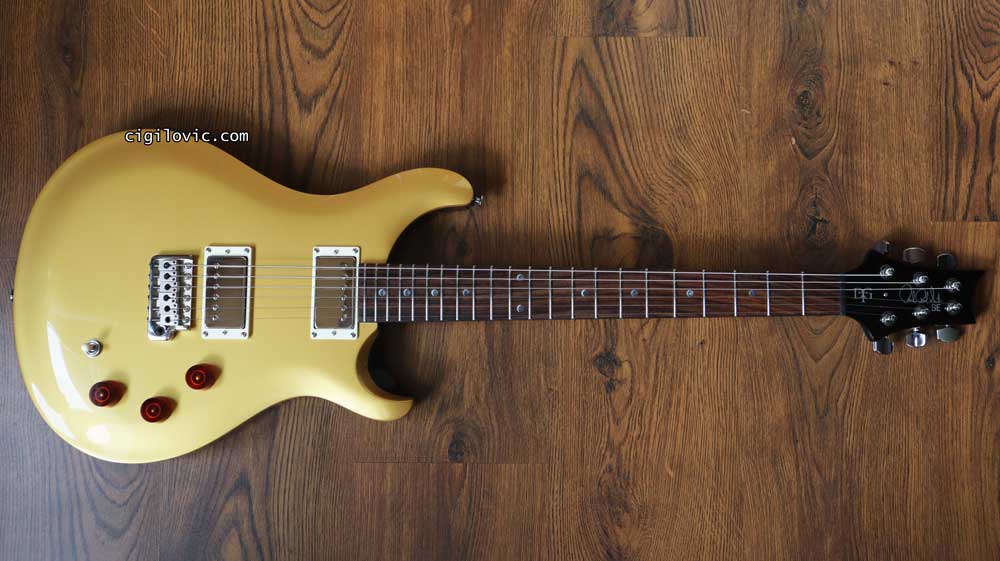
Every aspect of the SE version was carefully considered — from the neck carve and fretwork to the colour choices, pickups, and control layout.
Under the hood, you get a pair of vintage-voiced humbuckers, each with its own volume control, plus a push/pull master tone knob that lets you tap the coils for those glassy single-coil tones. It’s a super flexible setup that gives you tons of tonal options without ever getting in your way.
Add to that a maple top, mahogany body, 22-fret mahogany neck with a rosewood fretboard, and PRS’s signature bird or moon inlays (depending on the finish), and you’ve got a seriously gig-ready guitar that nails the DGT vibe — just at a much friendlier price.
“I didn’t just rubber-stamp this. This guitar is something I have been very involved in and am really proud of. The SE Series is lightyears ahead of anything I could get my hands on when I started playing – it’s amazing how far the quality has come – and I am proud to be able to offer this guitar to more people.” – David Grissom
Before we do a deep dive with individual sections of this unique PRS guitar, let’s first have a quick look at the tech specs below!
PRS SE DGT Tech Specs
| PRS SE DGT | Tech Specs |
|---|---|
| Body Construction | Solidbody |
| Top Wood | Maple |
| Veneer | Flame Maple (Plain Maple Top on Gold Top) |
| Back Wood | Mahogany |
| Top Carve | Shallow Violin |
| Number of Frets | 22 |
| Scale Length | 25" |
| Neck Wood | Mahogany |
| Neck Construction | Multi-Ply |
| Truss Rod | PRS Double-Acting |
| Neck Shape | DGT |
| Neck Depth at the 1/2 Fret | 27/32" |
| Neck Depth at the 12 1/2 Fret | 61/64" |
| Neck Width at the Nut | 1 21/32" |
| Neck Width at the Body | 2 1/4" |
| Fretboard Wood | Rosewood |
| Fretboard Radius | 10" |
| Fretboard Inlay | Moons or Birds (finish dependent) |
| Headstock Logo | Signature "SE" |
| Neck/Body Assembly Type | Set |
| Bridge | PRS Patented Tremolo |
| Tuners | PRS Designed Tuners |
| Hardware Type | Nickel |
| Nut | PRS |
| Truss Rod Cover | "DGT" |
| Treble Pickup | DGT "S" |
| Bass Pickup | DGT "S" |
| Controls | Two Volume Controls w/ Push/Pull Tone Control and 3-Way Toggle Pickup Switch |
| Strings | PRS Classic 10-46 |
| Tuning | Standard (6 String): E, A, D, G, B, E |
| Case | Gig Bag |
| Made In | Indonesia |
As mentioned above, PRS SE DGT is built upon the much-loved McCarty platform. As with almost all PRS guitars, PRS’s approach is to fill the gaps in between Strat and Gibson-style guitars.
McCarty platform basically indicates this particularly modern, and improved take on these iconic guitars, featuring a mahogany body, mahogany neck with a rosewood fingerboard, with a set-neck construction.
While these are reminiscent of Les Paul and SG-style specs, this template also offers specs from a Strat-style guitar, too. We also have a PRS-designed tremolo system, with dual humbuckers, separate volume controls with coil-splitting functions as well.
With these specs combined, and further proposed with unique features such as a 25-inch scale length, one could easily obtain all the necessary variety of guitar tones out of a single guitar.
Although I had featured Cort M600 electric guitars as the PRS Killer instruments, I was aware that there were differences in terms of the unique specs that PRS would offer. During my service in the musical instruments business, I had the chance to test many PRS SE guitars, and every time I tested them, I was so surprised by the build quality. Back in the day, these SE instruments were made in South Korea, then later moved to Indonesia. Ads - Check out these ads to support this web page
Since I had only limited time to test, record and ship these guitars more than a decade ago, I can only remember the moments. There was not a single moment of disappointment with SE guitars! But I had never owned a PRS SE before, so this time, my review will be more detailed and possibly a lot more honest as I have had some time to investigate and monitor how this guitar reacts to a variety of things.
Before we dive into the details of each section of the guitar, let’s have a listen to the demo I made for you.
PRS SE DGT Review & Sound Demo (no talking)
For the demo video, I used my PRS SE DGT and Marshall Studio Vintage SV20H as my base tone. I also used multiple overdrives such as Voodoo Lab Sparkle Drive, Crazy Tube Circuits Unobtanium RAW, Boss SD-1, and DOD 250 Preamp to further add more gain to the top of the Plexi sound.
I also used a variety of effects, such as Ibanez CS Mini Chorus, MXR M68 Uni-Vibe Chorus/Vibrato, MXR Custom Shop Phaser, CAE MC404 Wah, and MXR Carbon Copy Deluxe, to bring out different flavours of the guitar using different pickup settings.
For clean tones, I only used my amp along with an Ernie Ball EB6180 VP-JR so that I could lower the input volume and get clean tones out of my Plexi amp.
Last but not least, I used my Ibanez Pentatone EQ, Ibanez Pentatone Gate (PTGATE), Suhr Reactive Load and Two Notes Opus, as well as my RME Babyface PRO FS audio interface and Genelec 8020DPM monitors. I only used Wave Alchemy Magic7 as my reverb plugin.
I hope you enjoy these sounds!
I shot this video with a brand-new, out-of-the-box PRS SE DGT. We will discuss some nitty-gritty details about the guitar; however, I also wanted to share the video below, which features a restringing and instrument care session of my DGT.
If you are interested in watching these kinds of videos, here you go! 🙂
PRS SE DGT Restringing & Instrument Care Session
PRS SE DGT Review
As mentioned above, PRS SE DGT is built on the infamous, unique, and pioneering design template of the McCarties. It features a nice, pretty average-weight mahogany body.
It features all the unique specs of this template, but comes with DGT’s own unique attributes.
Headstock
DGT features the classic PRS headstock design as shown below. This design is not only intended to look cool, unique, and modern in comparison to traditional LP-style headstocks, but also to address the inherent problems associated with these traditional designs.
As you can see, the potentially problematic strings, G and D, go straight through the nut slots, and not with an angle. This definitely adds to the tuning stability.

One drawback of this design, I just realised while restringing the guitar, was that when you use a pegwinder on the low E and high E strings, you may hit that pointy bit on the headstock.
That pointy bit is located next to the tuning peg, and when you add the thickness of a pegwinder to that narrow area, you may hit that part every time you turn the pegwinder. So I would be cautious while using such accessories.
Nut
Next, we have the nut. According to PRS, this is a PRS nut. I couldn’t find any additional information claiming whether this is a self-lubricating or a regular plastic nut.
It looks like a Graph Tech one for sure. The first thing I noticed was that the string slots seemed to be cut very deeply. I believe this is how PRS does things! Also, there was a slight chip on the high E side, as you may notice in the image below. Not sure if that was intentional, but here we have it.

As you may have experienced, tuning problems are usually caused by the nut. People (including me!) used to think that the tuning problems should always come from the tuning pegs, but actually, the nut is almost always the culprit.
Tuning stability of PRS SE DGT is no superior to any tremolo-equipped (non-locking) guitar I have ever tried. So when you use the tremolo bar regularly, chances are you might need to check the tuning.
Are there any guitars with a non-locking tremolo system promising extremely high tuning stability? I don’t know, I have never encountered one. Maybe boutique-level builders could come up with such guitars, or maybe guitars with roller nuts would be the answer. But, yes, for PRS SE DGT, I’d say it performs as expected. 🙂
Tuners
Tuners used here are also PRS-designed tuners. These are non-locking, standard guitar tuners. I didn’t encounter any issues with these, but out of the box, these tuners were too loose in my opinion and experience.
For these standard design tuners, you can usually adjust the rotation feel by adjusting the screw located at the top of each peg. Sometimes, if you play an old guitar that has had no adjustment made to these screws, you may feel like the pegs are too loose. Therefore, it’s easier to have tuning problems.
For transparency, I had to tighten these screws (almost all of them) to get a better grip.
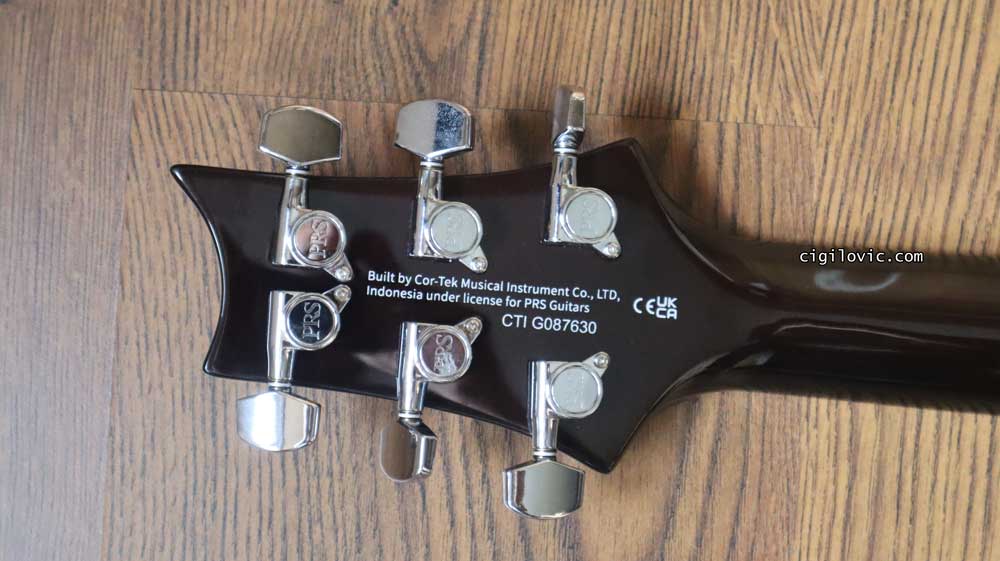
Also, I had to slightly tighten the bolts located on the front, as they were also not so tight. As you can see, we have the serial number, as well as the country of origin, and manufacturer info.
As I mentioned in my multiple reviews here, PRS SE DGT is also manufactured by the Cort company! 🙂
Neck
Next, we have this unique neck! According to PRS, the neck profile is called the DGT neck profile. That’s why I would call this unique. However, in the interviews with David Grissom, he states that this was taken from his much-loved 2010 PRS Gold Top.
I must say the neck on DGT is one of the most comfortable necks I have ever played. It’s not a skinny neck at all. It has some meat to it, and also a slight hump in the centre area that you feel when you bend notes.
I would normally not prefer such additional meat on the neck there, but while bending notes, I felt like my palm was supported a lot better than on my guitars with very slim, modern neck profiles.
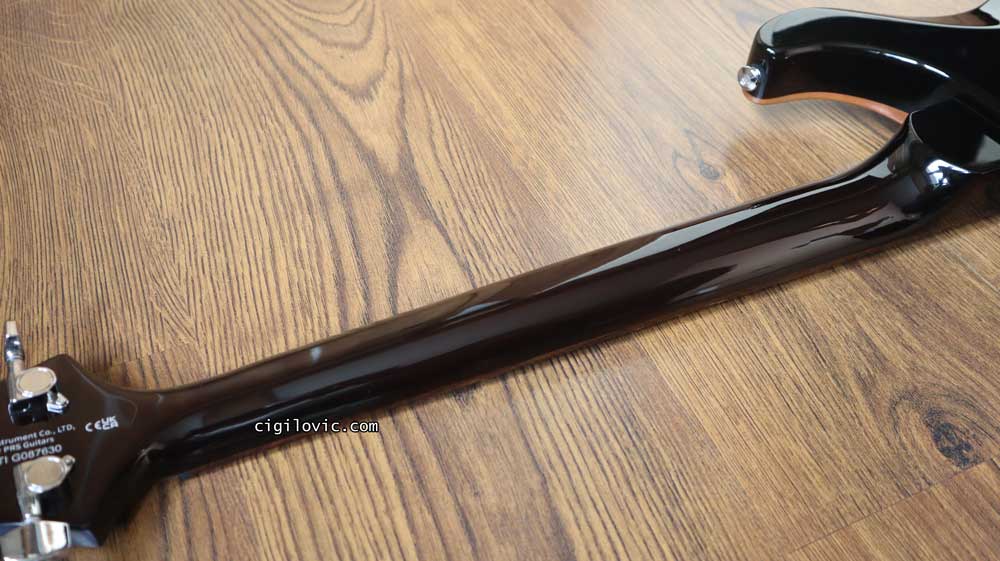
Out of all my electric guitars, I’d say my PRS SE DGT has the fattest neck. As you may know, I currently have a Fender USA Standard and MIJ Stratocaster, FGN Boundary Odyssey, Ibanez AR300, and RG565 guitars at my disposal.
PRS’s neck reminds me of my USA Standard Stratocaster, but with a beefier and more like D vibe to it. This beefy neck also yields great acoustic tones out of this guitar. PRS SE DGT resonates like crazy, no joke!
While talking about the neck, let’s not skip this wonderful set-neck construction. This is a unique PRS-style neck & body construction, and I think it’s one of the best in terms of playability, comfort, and aesthetics.

Issues with Neck Finish
It wouldn’t be a proper cigilovic.com review if I never documented a problem, right? 🙂 While inspecting the guitar, I immediately spotted these issues shown below. The bottom part of the neck, around the mid area (around the 9th fret) on the fretboard, had these finish issues right out of the box.
I found a similar problem in the area of the 7th fret as well. I contacted Thomann and asked for a discount. However, they wanted me to send this back. Unfortunately, I was about to leave for my annual vacation, and I couldn’t arrange the shipment.

Also, the fretwork (which we will be talking about) was top-notch, so I didn’t want to take the risk of sending this back and receiving a better-looking one with worse fretwork (you never know!).
Fingerboard
Based on the official tech specs, PRS SE DGT comes with a rosewood fingerboard. I must say this looks like a rosewood that I have never encountered. It has a lot of figures and shades across the board, and I think it’s a very unique one.
Note that I took these photos after I did my first restringing and maintenance of the guitar. Out of the box, it looked pretty dry, and the frets had some sort of white dust around them across the board.
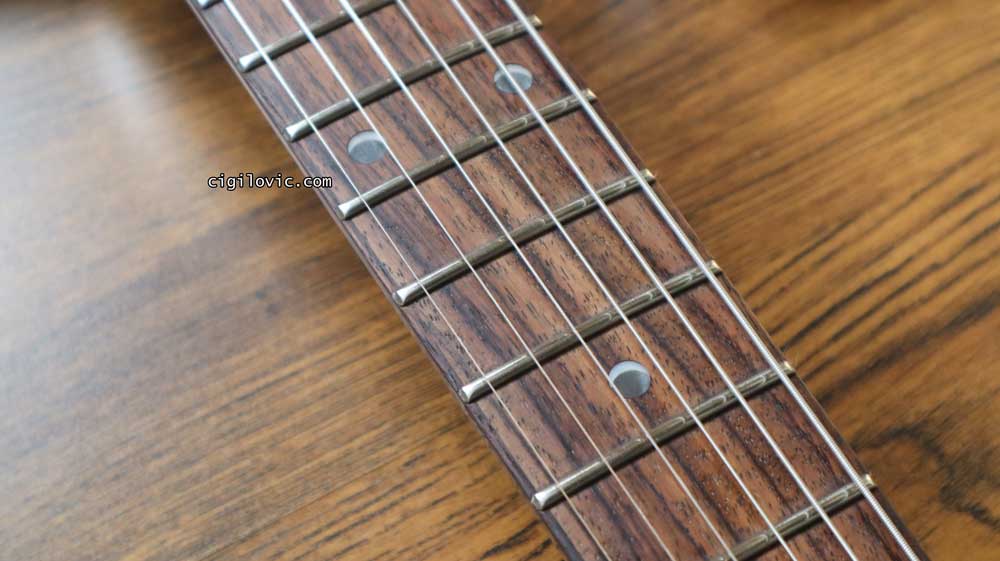
Also, I have started experimenting with PRS Tung Oil recently, and I must say I’m so impressed by it! There’s a distinct smell to it, and it really adds a dark vibe to the rosewood fingerboard that I have applied it to so far.
Frets
PRS SE DGT comes with 22 medium jumbo-sized, nickel frets. Although the material of the frets is not mentioned, I believe these are standard nickel frets. Out of the box, the frets were in a pretty good state. I wouldn’t say they were nicely polished, but it was pretty good for the price point. Ads - Check out these ads to support this web page
As you may have seen in the video above, I used steel wool to completely polish the fretboard as well as the frets, and applied PRS Tung Oil. This made the fingerboard and frets pop intensely, and the entire vibe and look of the guitar suddenly changed.
Of course, these basic maintenance operations should be required with most guitars at this price range. However, I think the fretwork is more crucial.
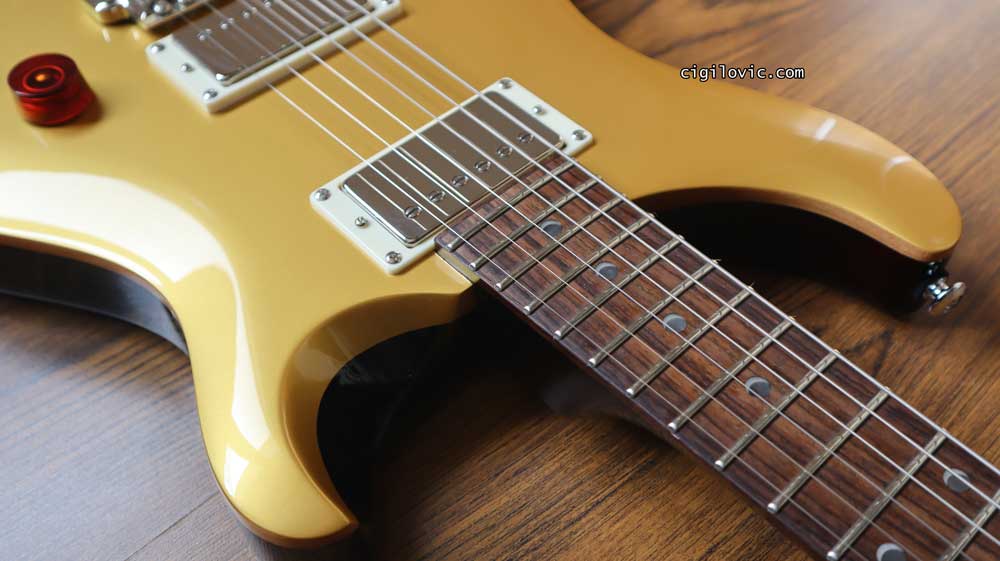
Fretwork on PRS SE DGT is pretty much impeccable right out of the box. I’m very impressed by the craftsmanship, and as I mentioned, it was the reason I wanted to keep this! Well done, PRS!
One additional thing to mention here is the last bit of the fingerboard on the DGT. Not sure if you can see from the images above (feel free to check it on Thomann’s photos), but there seems to be a tiny patch done at the end of the fingerboard, as it looks like this tiny part is a separate piece.
I thought mine had this, but the photos on Thomann’s webpage also show an identical pattern. It’s probably a way to patch things together (I wouldn’t know!).
Body
Next, we have this lovely PRS-style body shape, featuring a mahogany body and a plain maple top. On the Tobacco Sunburst finish option, you will have a maple top, and possibly a flamed maple top veneer.

I somehow wanted to go for the gold top colour, as I have recently found gold colour variations pretty attractive! 🙂 The paint job is also top-notch. I couldn’t spot any anomalies with the paint job.
PRS SE DGT weighs around 3.3kg, and it offers a pretty comfortable playing experience in both seated and standing positions.
On the back, we have a very unique finish as well. Although it looks like a black colour, it is not! It’s a very dark brownish colour that allows you to see the wood grains, but ever so slightly.
To be honest, I never liked plain black colour on the back of any guitar. It should either allow us to see the woodgrain or match the top colour, in my opinion.
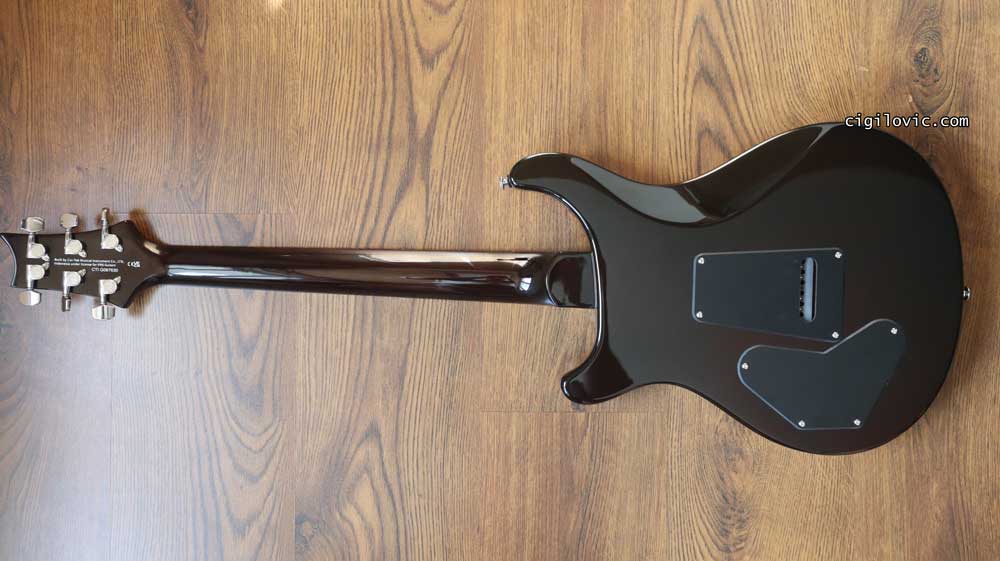
As you can see, both tremolo and electronics cavity feature these unique-looking plastic covers. Of course, as always, I removed them to see what’s inside, and also document it for you! But first, let’s slightly talk about the tremolo system.
Tremolo
PRS SE DGT features a PRS-designed tremolo system. Out of the box, the height, balance and setup of the tremolo were pretty good. This tremolo definitely doesn’t feel cheap at all. It has a nice quality to it that you can feel immediately.
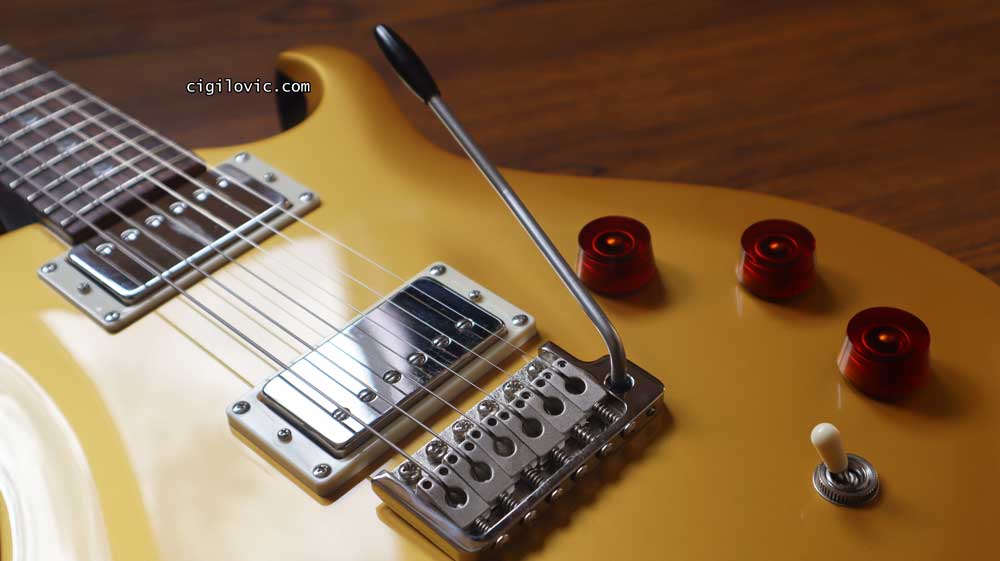
As I mentioned, it performs as expected. When you have a tremolo system and don’t have a locking nut, there’s always the risk of going out of tune after having used the trem bar intensely.
Honestly, this is not a negative remark. So far, all the tremolo systems I have used and experimented with have had the same result. But a FR-style tremolo with a locking nut is far better than anything contrary to the common belief that FR-style tremolo systems are the worst in terms of tuning stability! 🙂
Tremolo Cavity
As you can see below, the tremolo cavity looks pretty tidy, and the PRS-designed tremolo system comes with 4 springs here. The block is pretty thick and dense.
The only issue with the springs was that when I played a C note, they would vibrate like a spring reverb tank! 🙂 It was really loud, and the ring had a great sustain. Some people may like this, though.
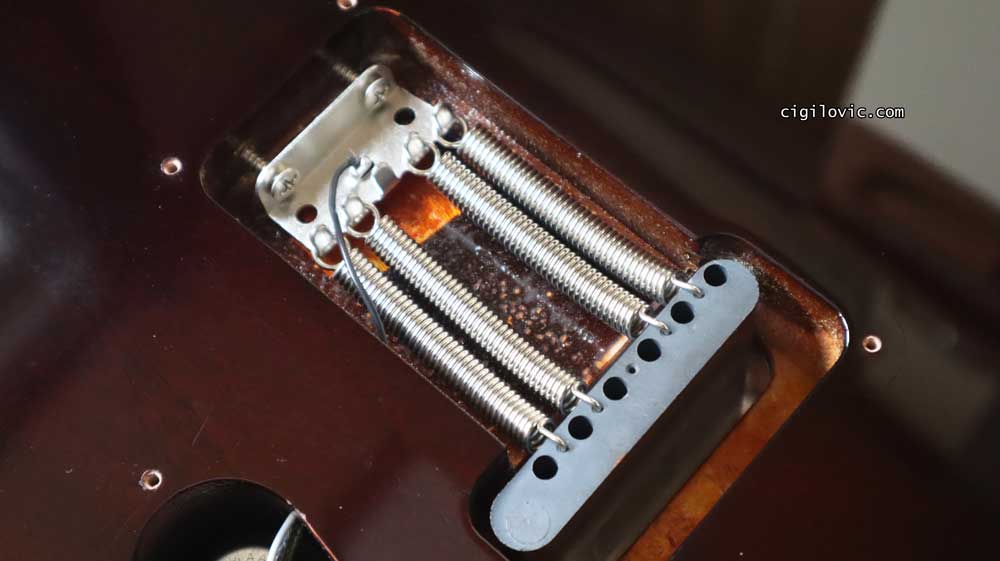
I really didn’t put any effort into fixing this, as it’s not urgent. But usually, you can insert some foam inside the springs, and it just fixes this problem.
Electronics & Controls
Unlike traditional controls on most guitars, PRS SE DGT has its own character and David Grissom’s preferences implemented here. DGT features a 2-volume and a master tone control also acts as a push-pull switch to split those humbuckers.
On an LP/SG-style control layout, you have your nearest volume knob located next to your bridge pickup, but it controls the neck volume. But with DGT, you have your bridge volume located near your bridge pickup. I think it makes a lot of sense as you spend most of your time on the bridge pickup (at least I do, and I believe most players do).
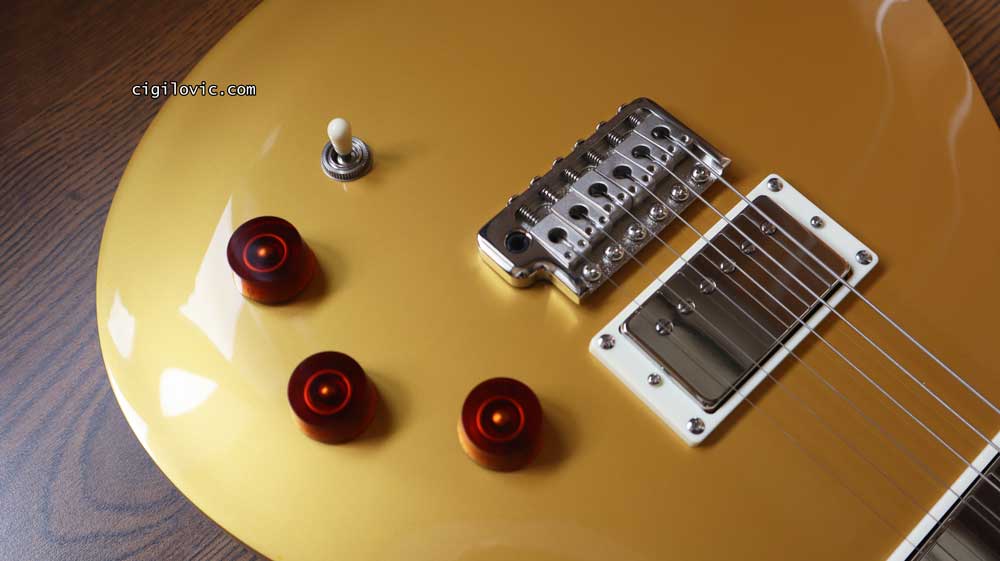
There’s also a 3-way switch located far back on the body. This is the feature I don’t like about PRS guitars. I know some PRS guitars offer a blade switch located in a more traditional location on the body. But personally, this is placed too far back for my ergonomics. I would prefer an LP-style pickup selector location over anything.
The pots and knobs are pretty well fit, and I didn’t encounter any issues using them, such as pulling the tone knob while trying to activate the push-pull switch.
The switch, on the other hand, was a little stiff and tended to get stuck between positions, resulting in a signal cut off. I applied DeOxit, and as always, it immediately solved this problem. Luckily, it wasn’t a permanent issue!
Electronics Cavity
Next, we have the electronics cavity. You have your standard Alpha pots, ceramic cap, switch and output here. I would say it’s pretty clean wiring, looks a little messy, but I have seen worse.
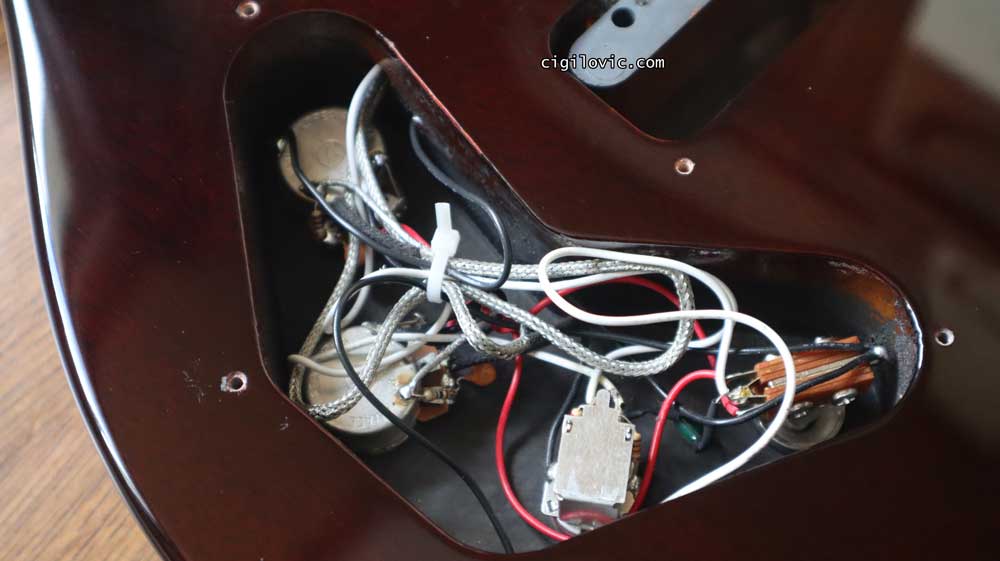
Multiple Inspections?
Just as additional information for you. These inspection stickers below were on the electronics cavity. Looks like there were at least three inspections made, and they still missed the finish problem! 🙂
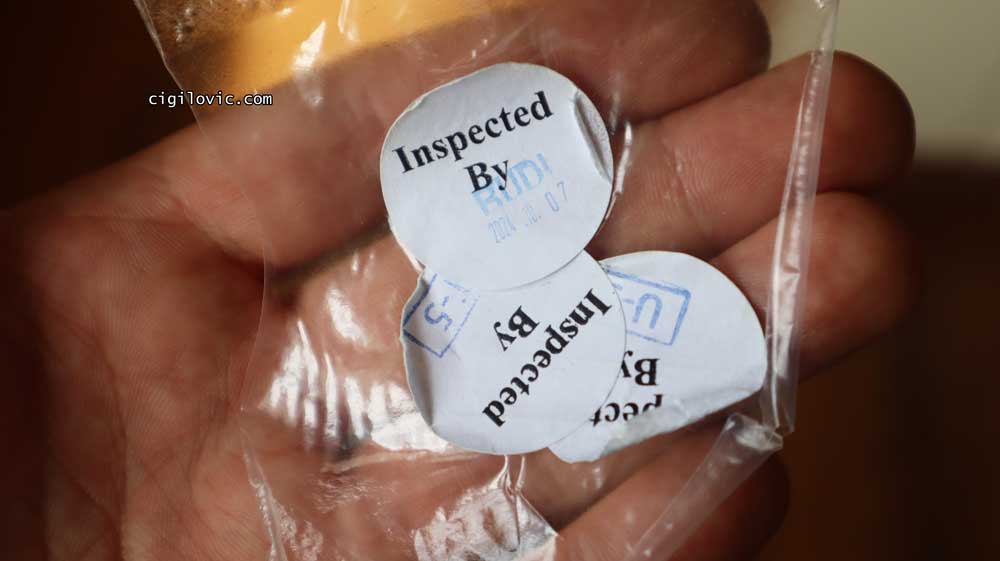
Jokes aside, I believe the finish issue occurred after the factory inspection was completed. Maybe those frets and the wood there had some shrinking problem due to the different climates it had to endure. We will never know.
Pickups
PRS SE DGT comes with a pair of DGT “S” humbuckers. The OG DGT has DGT pickups; therefore, the “S” probably indicates that these are the same pickups designed for the SE version.
As far as I remember, this was mentioned by either David Grissom or Paul Reed Smith that these pickups were just clones of the original DGT pickups, possibly made in the Far East.
As soon as I started playing my SE DGT, I realised that these pickups did not offer a lot of output that you would find on modern pickups, and definitely had a vintage vibe to them.
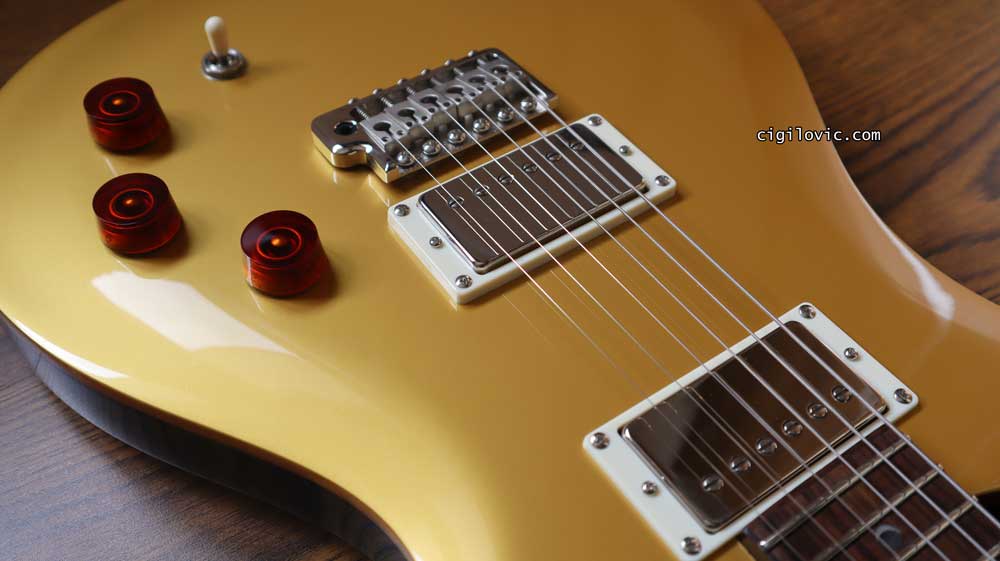
In order to prove my point, I had to measure them. Here are the measurements from my multimeter!
Bridge 9.15K
Middle 4.18K
Neck 7.75K
When split, I had these readings below:
Bridge Split 6K
Middle Split 2.65K
Neck Split 4.75K
These pickups have a distinct sound! I think they sound very open, mellow, and not so compressed all around. This helps using my DGT with my Marshall SV20H, and allows me to add different overdrive/distortion pedals on top of this base tone.
Since these don’t generate a huge output, they offer a lot more headroom for stacking overdrives. Note that these pickups may not be for everyone!
The easiest thing to do whether to just find out if you like these is to just listen to David Grissom’s albums! Although he wasn’t using an SE version while recording his albums, you will easily identify this distinct sound as DGT “S” pickups pretty much sound identical.
Gig Bag
Last but not least, you have a lovely padded gig bag with your PRS SE DGT! This gig bag comes with, I believe, every PRS SE, and we should really appreciate this. As I stated in my Fender Special Run MIJ Hybrid II Stratocaster review, Fender even hesitated to add a proper, padded gig bag, but just added the cheapest gig bag with a Fender logo on it.
So not all companies are worried about losing a little bit of their profit, and instead give that back to the customers! The gig bag is a very ideal, perfectly executed, padded one with tons of pockets here and there! I really love it!
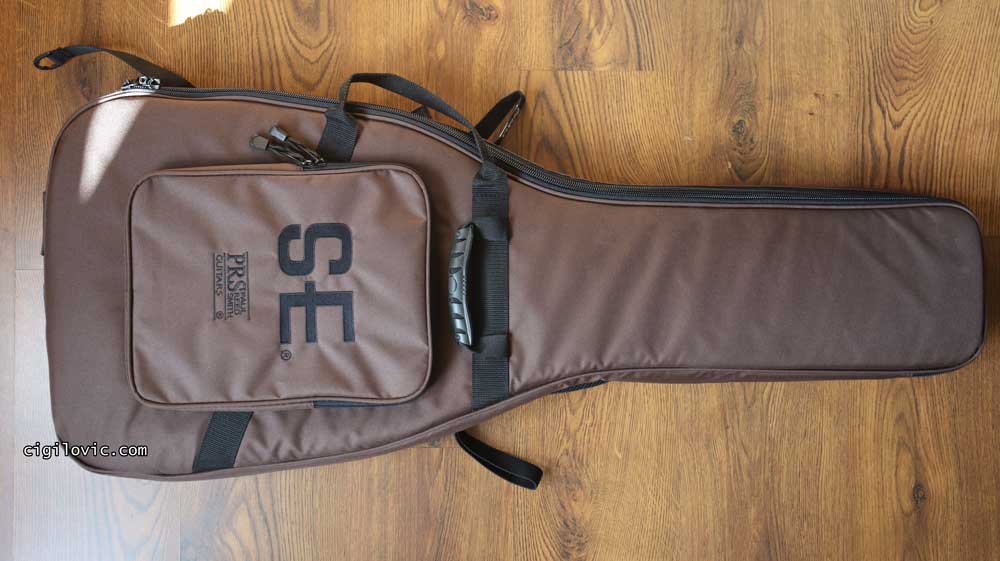
And finally, just to mention here that it comes with a tiny allen key for adjusting saddles on the bridge, as well as this truss rod adjustment key, which reminds me of Gibson-style ones. I had to use the key a couple of times as I changed the string gauge and was experimenting with different tunings.
I can confidently say that there were no issues adjusting the truss rod of my PRS SE DGT. Everything was smooth!
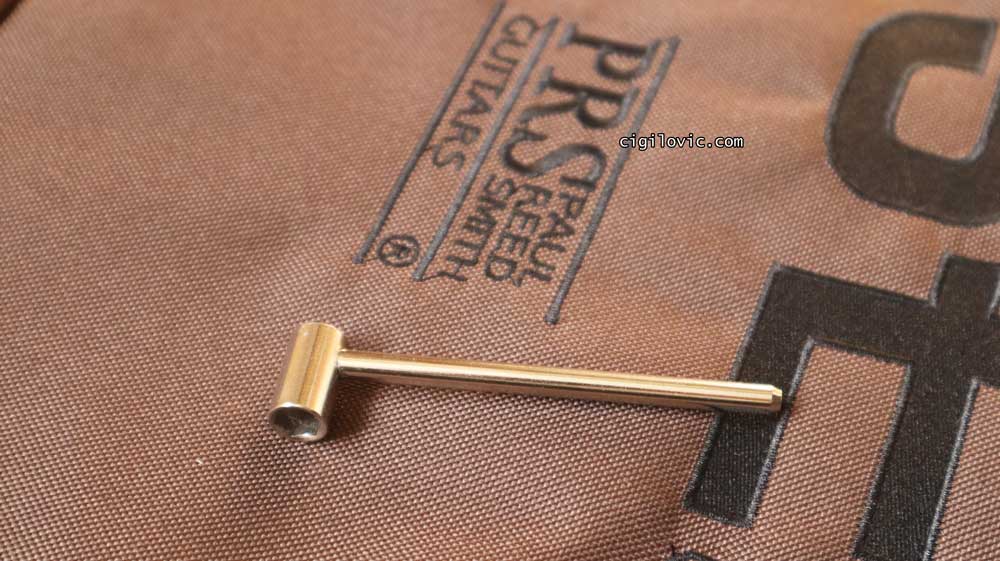
Verdict
As you may already feel from the tone of this article, I must say I’m quite positive about PRS SE DGT. I usually opt for mahogany bodies, maple tops, and rosewood boards in my guitars as these are my favourite combinations of wood, and I get a very familiar feel with them.
You may come across this combination of wood in Les Pauls, SGs, and similarly designed copies or clones. Personally, I really don’t get along well with LP-style guitars. For me, playability is very bad with LP-style guitars. They are heavy, bulky, and pokey. I know they sound great, and they have a unique vibe. But I could never bond with them.
But I’m a big fan of double-cut, lighter versions of this combo. So SG-style guitars are always a lot better for me. You may have heard me say that my favourite guitar is my Ibanez AR300, wondering why? 🙂
PRS SE DGT checks all the marks for me in this matter! It features the exact combination I love the most. But it’s even sleeker, lighter, and offers modernised, and maybe “corrected” features of the legendary combination.
Apart from the issues I spotted on the neck finish, which are all cosmetic issues, I think the build quality is top-notch! One of the best I have seen so far!
Of course, I would love to provide you with longer-term feedback, as the guitar may start giving me some trouble in the future. For that, please subscribe to my newsletter! 🙂
I believe long-term inspection and review of guitars is a lot more important and valuable, so I will be updating the article if I keep the guitar that long.
Things to Consider
There are a couple of things to be careful about with this guitar and generally with PRS guitars. First of all, you should be aware of the fact that PRS has a very unique design and has its own thing.
That means you may not immediately bond with the instrument, so I suggest that if you ever buy a PRS, give yourself some time to adapt. I played many SEs back in the day, and also many Cort guitars, which featured pretty much the same body design, so it was a familiar feeling for me.
Also, if you are considering this guitar for lower tunings, please consider the unique scale length. Let me give you some examples. I have had some experience with different gauges of strings and different tunings on guitars with the LP scale length.
For instance, on my Ibanez AR300, I usually go with 10-46 or 11-49. Based on my experience, I can even use 11-49 with a standard tuning, and it’s still playable, easy to bend, and play in standard tuning without any drastic changes to the feel.
It’s also possible to go down to standard D tuning with 11-49, but it’s a little risky as it can get really loose if you hit the strings really hard.
I just wanted to experiment with this gauge on my PRS SE DGT, and it was extremely loose! I believe this shorter scale length is the problem. So I would say go for at least 12-52 gauges if you want to go down to standard D, or drop C tunings.
With 11-49 gauge, standard tuning is pretty tight-feeling, but standard D is not so playable in my opinion. So currently I’m playing with an 11-49 gauge on half-step flat tuning. I think the feel is a lot better.
Overall, I must say I’m very impressed by the PRS SE DGT! It really assured me that moving the manufacturing to Indonesia from South Korea did not have a huge negative impact on the build quality. I’m still ignoring the finish issue; it may happen to any guitar.
Here’s a real example from a former MI professional for you. While working as an import manager in an MI distributor company, I was also responsible for the e-commerce section. One day, we sold a really high-end, made-in-Japan ESP guitar. It had waited in our warehouse for many years. The guitar was transferred to our office and HQ.
As I had experience with guitar testing, I wanted to see the guitar before shipping it. And believe me, this was not the process in my new company. I checked the guitar, and it was all perfect until I started inspecting the headstock area. There was a huge finish crack! I had to arrange the export back to Japan. So as you can see, these can happen to any guitar.
PRS SE DGT offers huge value/money. I think the price tag is fair considering that it’s a signature model, and PRS needs to pay David Grissom a little bit on these as well. I will definitely keep you posted here in the long term and report if I spot any problems that may occur in time.
Where to PRS SE DGT?
Although PRS SE DGT was released back in 2023, it’s still in production, and it seems to be widely available. As I always do, I got mine from Thomann. I believe Thomann’s competitive pricing policy is unbeatable!
Also, don’t forget to check out other finish options and varieties of PRS SE DGT below. There are full mahogany versions as well as some exotic wood combinations as the top woods on DGTs here on Thomann.
Check out PRS SE DGT on Thomann here
You can also have a look at Reverb listings for SE DGT models. The sellers on Reverb usually price the items a lot higher, as they have to pay a huge commission back to Reverb. But in case you are interested, here you go!
Check out PRS SE DGT on Reverb here
Last but not least, PRS also offers their guitars, accessories and parts on Amazon. If you want to check out the current offerings, please do check the link below.
Check out PRS SE DGT on Amazon here
I hope you have enjoyed this real guitar review article and the materials provided here. Thanks for visiting my blog and supporting me so far! I will hopefully see you in the next review here!
Osman Cenan Çiğil – cigilovic.com
Post your comments and feedback here
By submitting a comment, you accept that you will be automatically included in the newsletter. You can always opt out in case you are not interested in the content updates.Check out the best used gear website!




